Diamond Clarity
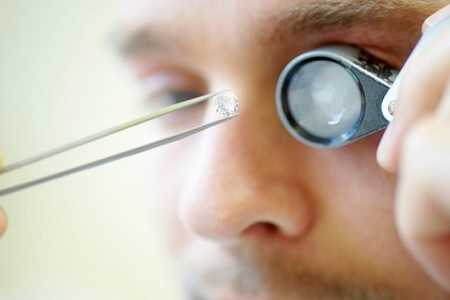
Did you know that diamond clarity is the most misunderstood factor when it comes to the 4Cs? In fact, most people assume that a high clarity grade is required for better sparkle and to avoid eye visible inclusions.
The truth is far from that.
In this section of the website, you will learn the technical aspects of what diamond clarity is and what it isn’t. I am also going to reveal insights on what to look for in a diamond and how you can save a lot of money by shopping smart.
Let’s jump right in!
First of All, What is Diamond Clarity?
When diamonds are created under extreme conditions, natural flaws are inevitable by-products of the formation process. Interestingly, a diamond’s inclusions work in a similar fashion like our fingerprints do. This means you can identify a diamond from another just by using its inclusions as a reference.
Diamond clarity is a qualitative assessment of the flaws present in a diamond.
Basically, the flaws can be classified into 2 types of categories depending on where they are found; blemishes (external flaws like scratches and chips) and inclusions (internal flaws like pinpoints and crystals).
Obviously, the lesser amount of flaws a diamond has, the higher the clarity grade and value it possesses.
Diamond Clarity Chart – An Overview And Visualization

A flawless diamond is one that doesn’t have any external blemishes or inclusions and is abbreviated as FL. On the other hand, the lowest clarity grade is abbreviated as I3 and it represents a severely included diamond that typically has ugly eye visible flaws.
Generally speaking, diamonds with VS2 grades or better are usually eye-clean (inclusions cannot be seen without the aid of a loupe). At lower carat sizes, stones within the SI1 and SI2 ranges are also eye-clean and can offer fantastic value for money.
However, it is also important to note that eye cleanliness is very subjective. Hence, each diamond in the SI ranges should be judged separately because of the different kinds of inclusions present in the stone.
Personally speaking, I don’t recommend buying stones below I1 clarity grades as they usually have inclusions that can be seen with the naked eye and/or may also pose durability issues for your engagement ring.
What Do the Grades in GIA Clarity Scale Mean?
The grading process involves a skilled gemologist who examines the diamond under a 10X powered microscope. The diamond is subsequently classified into a clarity rating based on an assessment of its inclusions.
Listed below is a quick breakdown of what each individual ratings mean. For full details on any particular clarity ratings, feel free to click on the corresponding link to see real-life diamond examples (with videos and photos).
– FL (Flawless) – No inclusions or visible blemishes under 10× magnification.
– IF (Internally Flawless) (IF) – No inclusions. Minute blemishes are allowable (surface graining or details of polish) but barely visible to a skilled grader using 10× magnification
– VVS1 & VVS2 (Very, Very Slightly Included) – Inclusions are extremely hard to be detected using 10× magnification.
– VS1 & VS2 (Very Slightly Included) – Inclusions are fairly hard to be detected using 10× magnification and generally do not impact the visual beauty of the diamond.
– SI1 & SI2 (Slightly Included) – Inclusions are easily noticeable using 10× magnification and they are sometimes visible to the naked eye.
– I1, I2, and I3 (Included) – Inclusions are very obvious using 10× magnification. Besides potential durability issues, they can also adversely impact the diamond’s transparency and brilliance.
How Inclusions Are Listed And Labeled in a Grading Report
In a GIA grading report, all the flaws found in the diamond are collectively listed under in a section marked: “Clarity Characteristics“. Also, you might have come across a clarity plot that indicates the locations and types of inclusions found in the diamond.
In essence, the clarity plot functions as a map and you can see an example in the diagram below.
Typically, you will only find the diagram in full-fledged GIA reports for diamonds larger than 1.00 Carats. For diamonds smaller than 1.00 carats, the Dossier reports used will only offer a worded description of the clarity characteristics.
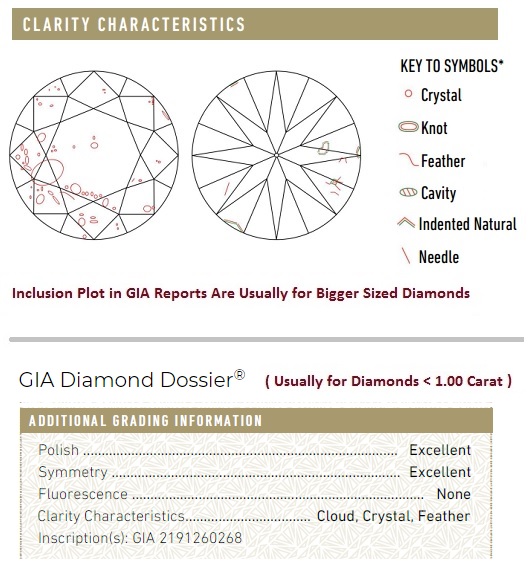
GIA Grading Report vs GIA Diamond Dossier Report
While an inclusion plot can be used for convenient stone identification, you need to know that it is not an accurate portrayal of the diamond’s actual real-life appearance. This is because the inclusions are mapped in a 2D manner and it doesn’t tell you how the inclusions look like or how they can affect the diamond’s beauty.
In fact, a cluttered and scary looking plot may not turn out that to be that serious in real life. On the other hand, a clean looking plot of a low clarity grade diamond may actually pose more of a concern to its appearance. I will talk about these issues in more details on a later page.
Clarity is One of the Most Misunderstood Factor in Diamond Buying
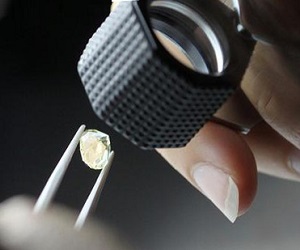
Based on the number of questions I received from readers, I know that many consumers have difficulties in deciding on the best clarity grade for their purchase. There is also a misguided mindset that a higher clarity grade would guarantee a diamond that sparkles more.
However, does clarity really affects how brilliant or sparkly the stone will be? Is it mandatory to buy a high clarity diamond just so that you won’t see any flaws with your unaided eyes? Should you pay thousands more just for a better clarity grade?
I’ll reveal the answers on the next page. More importantly, I’m also going to show you which are the best clarity grades to buy and the underlying reasons why you shouldn’t be wasting your money on VVS or IF diamonds…
Related Articles
Leave A Comment

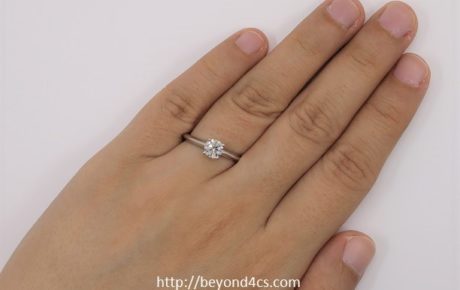

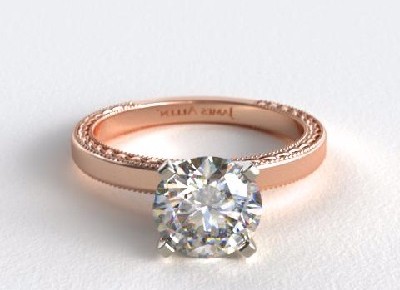
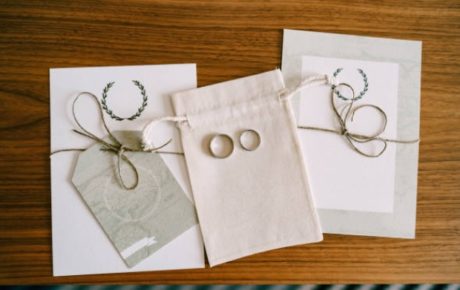









17 Comments
Hi,
Really interesting info on here! I know you can’t give a clear cut (pun intended) answer without seeing them or know more..
But – in your opinion – which is more important – carat size or colour?
I’ve been sent a few options from Tiffany (girlfriend loves Tiffany, so I’m guessing overpriced lol)
These are two I was looking at:
1) 0.44 E VVS1 $3960.00 USD
2) 0.52 I IF $4730.00
I can’t decide whether the lower carat but ‘better’ colour E is a better idea than the slightly larger carat but poorer colour?
(It’s an Emerald shaped diamond, by the way)
Any help would be hugely appreciated!
Adam
It really boils down to personal preference. An I colored emerald cut diamond may have a “tinge of yellowness” in it. Can you accept that? Is an internally flawless grade really necessary? If it isn’t why pay so much more for an aspect that you can’t appreciate with the naked eye.
Funny to read that yellowish colored diamonds [I] are cheaper but then on the other side I read that FANCY YELLOW diamond are so expensive. Could you give a comment about the price range for GIA REPORT 1213142504?
Appreciate your opinion
Thank you so much
Proportions don’t look good. Even if they are, I can’t offer constructive advice.
https://beyond4cs.com/buying-diamonds-blind/
Thank for answer!
What proportions would be good in your opinion?
https://beyond4cs.com/shapes/round/ideal-proportions/
Could you give me your thoughts on this diamond certified by GIA 2198418035, price is 8,500.
https://beyond4cs.com/diamond-prices/
https://beyond4cs.com/buying-diamonds-blind/
Hi Paul, I’m thinking of buying this diamond. Could you help me please? Do you think this diamond worth buying? Gia number is: 2228155232. I’m not so sure about the clarity.
https://beyond4cs.com/buying-diamonds-blind/
Hi Paul,
My fiance and i have gone ahead to purchase a 2.23 CT emerald cut diamond VVS1 H colour from an online retailer. I will be receiving the diamond by courier today. I would like to take it to an appraiser in The Woodlands area in Texas. Would you be able to give some insight or recommendations of who or where we should go to for this independent appraisal? Preferable if you could give some specific appraisers.
Thanks also for your very informative booklet on the 4Cs and your explanation of the diamond clarity scale.
Try this list: https://gemguide.com/stores/texas-jewelry-appraisers/
Why doesn’t White Flash provide us with the 360 degree viewing like James Allen ? It is impossible for a would be buyer without diamond knowledge and training to imagine what the diamond he wishes to buy would look like.
Would be great if White Flash had this technology.
White Flash does have videos of the loose diamonds in their listings. Recheck them and you’ll find it.
Hello Paul,
Thank you very much for your great website. It’s pretty resourceful.
I would like your insight please, I am wondering how a VVS2 would differ compared to a VVS1. Does it relate do the location of the inclusion? also if the inclusion is on the table is that a bad thing, would it affect the light performance in anyway?
I am picking between these two diamonds right now
https://www.jamesallen.com/loose-diamonds/round-cut/1.56-carat-g-color-vvs2-clarity-excellent-cut-sku-2185961
https://www.jamesallen.com/loose-diamonds/round-cut/1.61-carat-h-color-vvs1-clarity-excellent-cut-sku-2166059
One is an H VVS1 and the second is a G VVS2. Both are comparable in size and triple excellent. I am leaning to the G one. (It’s more expensive) but I was told if I don’t move to VVS1 from VS1 it’s not worth the money, and I shouldn’t get a VVS2.
Can you please give me your take on this one?
Thank you!
Hello Paul,
You did not reply my first question probably you’re busy but I wanna try to ask again.Is it Jamesallen reliable in order to buy diamond or Do they have quality diamonds such as white flash and other quality online shops ?
Thank you
James Allen is definitely reliable. In terms of cut quality, their selection criteria for the True Hearts range is slightly looser than that of White Flash or Brian Gavin. If you put in some effort to research, you may be able to find one that’s truly well cut.
Otherwise, just stick with White Flash or Brian Gavin to save the hassle.